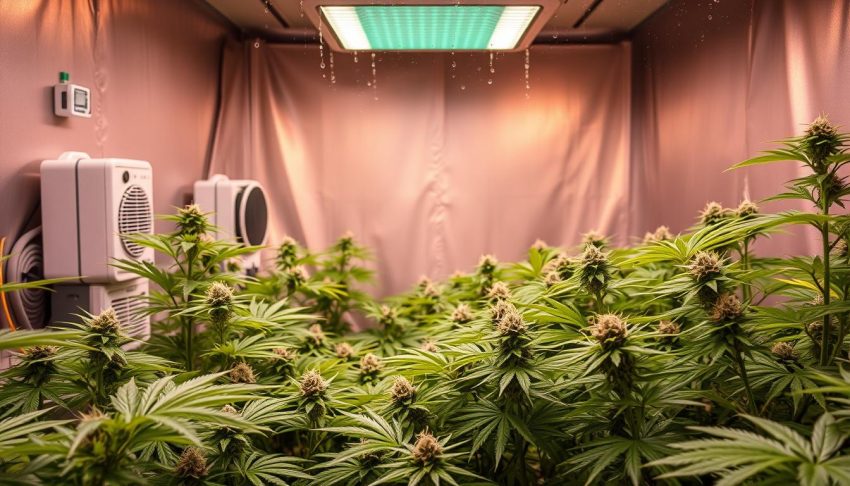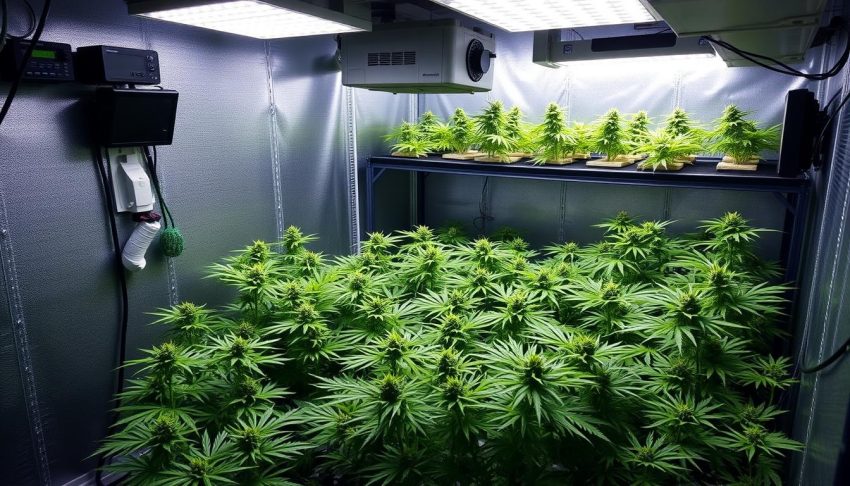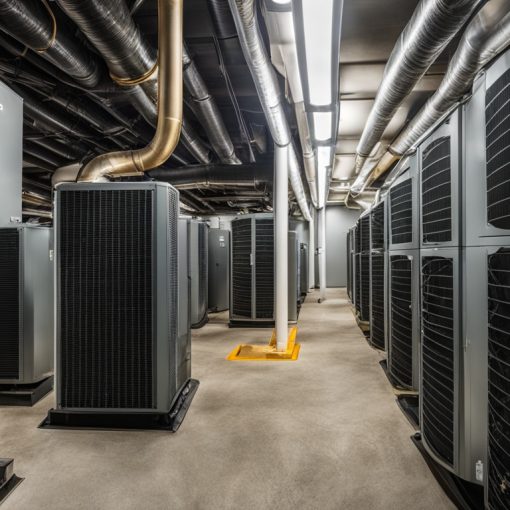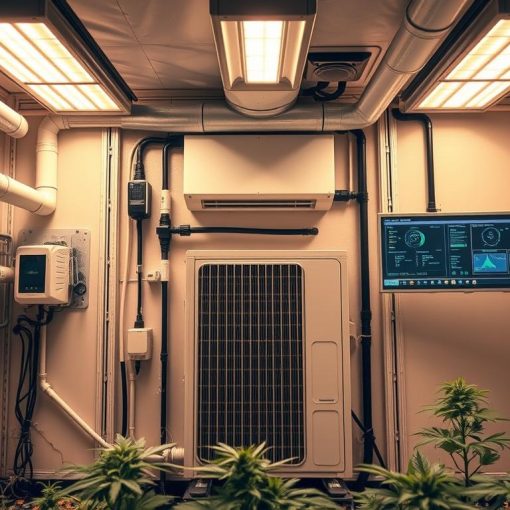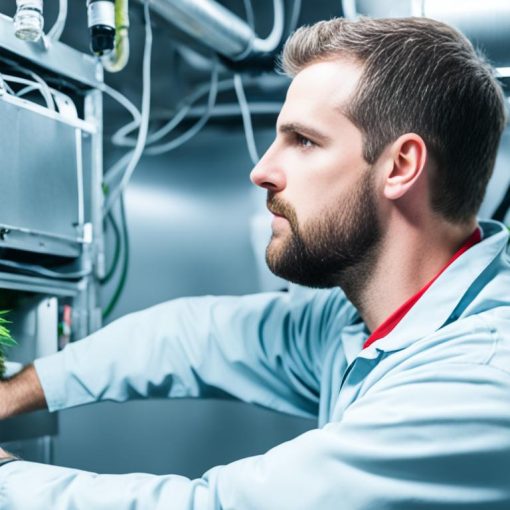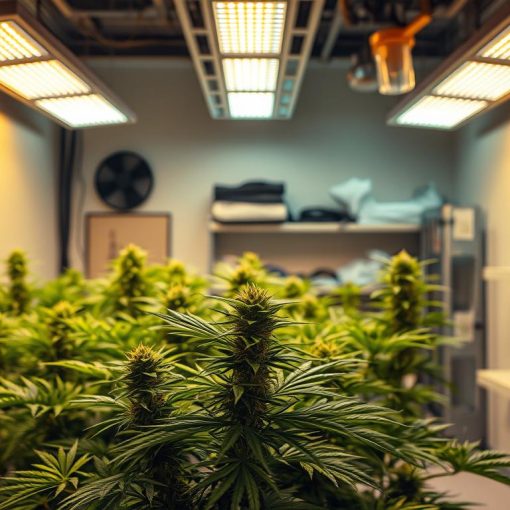Cannabis cultivation is growing fast, and growers know they need the right environment. Keeping moisture levels just right is key for healthy plants and good yields. TriCleanAir is a top name in cannabis climate control, offering solutions to manage moisture and humidity.
Key Takeaways
- Proper moisture management is essential for successful cannabis cultivation
- Excess humidity can lead to a range of issues, including mold, mildew, and impaired plant growth
- Dehumidification systems, ventilation strategies, and integrated climate control solutions can effectively address moisture-related challenges
- Monitoring and maintaining optimal humidity levels is crucial for maintaining a healthy grow environment
- TriCleanAir’s expertise in cannabis climate control can help growers implement robust moisture removal systems
Understanding Moisture in Cannabis Cultivation
Keeping the right moisture levels is key to growing cannabis well. Too much water can harm plants and reduce yields. High humidity also leads to mold and mildew, which can ruin the quality of the product.
Impacts of Excess Moisture on Plant Growth
Too much water can slow down cannabis plants. Waterlogged soil cuts off oxygen to the roots. This can stunt growth, delay flowering, and lower yields.
It also makes plants more vulnerable to pests and diseases. This can further harm their health and productivity.
Risks Associated with High Humidity Levels
High humidity levels help mold and mildew grow. These fungi can ruin the look and quality of plants. They can also produce toxins that are bad for both plants and people.
Keeping the right moisture levels is vital. It stops mold and mildew from growing. This keeps plants healthy and safe for use.
“Proper moisture management is the foundation of a successful cannabis grow operation. Failing to control humidity levels can lead to disastrous consequences for both plant health and product quality.”
Growers need to understand the balance between moisture and growing cannabis. By watching humidity levels and using good moisture control, growers can improve plant growth. They can also avoid mold and mildew and make safe, high-quality cannabis products.
Moisture Removal – Cannabis Climate Control
Keeping the right moisture levels is key to growing great cannabis. Moisture removal is crucial for cannabis climate control. It helps create a healthy space for plants to grow well and produce lots of buds.
Managing humidity in a grow room is a fine art. Too much moisture can cause mold, mildew, and slow plant growth. But, too little moisture can stress plants and hurt their health. Proper moisture removal is vital for a perfect grow room environment.
Growers need a solid plan for moisture removal. They use dehumidifiers, ventilation, and sensors to keep humidity just right. This helps control the grow room’s climate.
“Maintaining the right humidity levels is crucial for the health and productivity of your cannabis plants. Proper moisture removal is essential to creating an optimal grow room environment.”
By controlling moisture removal and cannabis climate control, growers can make their plants flourish. This leads to bigger yields and better quality buds.
Dehumidification Systems for Indoor Grows
Cannabis cultivation indoors requires effective dehumidification systems. Keeping humidity levels right is key for your plants’ health and growth. Choosing the right dehumidifier is crucial for a great growing space.
Selecting the Right Dehumidifier
Choosing the right dehumidifier for indoor cannabis is important. Consider these factors:
- Grow room size: The dehumidifier’s capacity should fit your grow space’s size for efficient moisture removal.
- Humidity levels: Know the humidity range your plants need. Pick a dehumidifier that can keep those levels.
- Energy efficiency: Choose Energy Star-rated dehumidifiers. They control humidity well while saving energy and money.
- Noise levels: Opt for a dehumidifier that’s quiet. This keeps your grow room peaceful.
- Drainage options: Make sure the dehumidifier has easy drainage. This could be a built-in pump or a condensate line connection.
By considering these points, you can find the best dehumidifier for your indoor cannabis grows.
“Maintaining the right humidity levels is crucial for the health and productivity of your indoor cannabis grows.”
TriCleanAir is a top name in cannabis climate control. They can guide you in picking the best dehumidifier for your grow space. Their knowledge in moisture management helps you create a thriving cannabis environment.
Maintaining Optimal Humidity Levels
Keeping the right humidity is key for growing cannabis well. The best humidity levels change with the plant’s growth stage. Generally, growers aim for 50-70% relative humidity (RH) in the vegetative stage. For the flowering stage, they aim for 40-50% RH.
Right humidity levels help plants grow strong and healthy. Too much moisture can cause mold and mildew. Too little can stress plants and hurt their growth.
- The vegetative stage needs higher humidity (50-70% RH) for fast growth and leafy development.
- The flowering stage prefers slightly lower humidity (40-50% RH) to avoid bud rot and boost trichome production.
- Keeping humidity steady throughout growth is vital for the best plant growth and yield maximization.
TriCleanAir leads in cannabis climate control with dehumidification systems and monitoring tools. These help growers keep optimal humidity levels during the whole growing process.
“Consistent humidity control is a critical component of successful cannabis cultivation. Growers who can maintain the ideal moisture levels will see a significant boost in plant health and overall productivity.”
Ventilation Strategies for Moisture Control
Keeping the right humidity in cannabis grow rooms is key for healthy plants. Ventilation is a major part of this. TriCleanAir, experts in cannabis climate control, say air exchange and airflow management are crucial. They help control humidity and stop moisture buildup.
Air Exchange and Airflow Management
Good air exchange is vital for a healthy grow room. It means bringing in fresh, dry air and taking out moist, stale air. This keeps humidity levels right for growing cannabis.
Managing airflow well is also important for controlling moisture. Fans and vents placed right can make a smooth airflow. This spreads moisture evenly, stopping humid spots that can cause mold and mildew.
- Use high-volume exhaust fans to remove moist air from the grow space
- Install intake fans to bring in fresh, dry air
- Place oscillating fans for a gentle, circular airflow in the grow room
- Make sure air exchange rates are high to keep humidity levels optimal
Using these ventilation strategies helps growers manage moisture. It keeps plants healthy and reduces risks from too much humidity.
Monitoring and Controlling Grow Room Environment
Keeping the right moisture levels in a cannabis grow room is key for healthy plants and avoiding mold. It’s important to watch and adjust the environment closely. Using sensors and controllers helps growers keep humidity just right for their plants.
Environmental Sensors and Controllers
Starting with good environmental sensors is crucial. These tools measure things like temperature, humidity, and CO2 levels. By placing sensors in key spots, growers can understand their environment fully.
Connecting sensors to smart controllers lets growers make climate changes automatically. These controllers can turn on dehumidifiers or fans to keep moisture levels perfect. Some systems even work with apps, so growers can adjust things from anywhere.
| Environmental Parameter | Optimal Range for Cannabis | Sensor Types |
|---|---|---|
| Temperature | 70-85°F (21-29°C) | Thermometers, RTD sensors, thermocouples |
| Relative Humidity | 50-70% | Hygrometers, capacitive sensors, resistive sensors |
| CO2 Levels | 1,000-1,500 ppm | NDIR sensors, electrochemical sensors |
By watching and adjusting the grow room, growers can make sure their plants are happy. This helps plants grow well and keeps moisture problems away.
“Proper environmental control is the foundation of a successful cannabis cultivation operation. Monitoring and managing the grow room climate is essential for maximizing plant health and yields.”
Preventing Mold and Mildew Growth
Keeping a healthy cannabis grow environment is key. Mold and mildew can harm plants, quality, and even the grower’s health. We’ll look at how to stop mold and mildew in cannabis grows.
Keeping moisture levels in check is vital. High humidity lets mold and mildew grow. With good moisture control, growers can protect their plants and products.
Proactive Measures for Mold and Mildew Prevention
- Maintain optimal humidity levels in the grow room, typically between 40-60%
- Ensure adequate air circulation and ventilation to promote moisture evaporation
- Regularly inspect for any signs of mold or mildew and address issues promptly
- Implement a comprehensive sanitation and cleaning regimen for all grow room surfaces
- Use dehumidifiers and other climate control equipment to actively remove excess moisture
By focusing on moisture control and following these steps, growers can lower mold and mildew risks. This protects plant health and keeps harvests quality.
At TriCleanAir, we’re pros in cannabis climate control. We help growers keep their environment right and stop harmful fungi. Our team can help you find the best moisture control for your grow space.
Integrating Climate Control Systems
TriCleanAir is a top name in cannabis climate control. They know how key it is to manage moisture levels well. Their systems work together to control humidity, air flow, and watch the environment. This helps growers get the best results from their cannabis.
Automated Solutions for Moisture Management
TriCleanAir uses the latest tech to make a perfect space for growing cannabis. Their systems keep an eye on humidity, temperature, and air flow. They adjust everything in real-time to keep plants healthy and strong.
This precision helps growers avoid problems like mold and mildew. It also makes sure their yields are always top-notch.
TriCleanAir’s systems handle dehumidification, ventilation, and sensors all at once. This makes it easy for growers to keep their grow rooms just right. They can focus on other important parts of growing while the system takes care of the climate.

